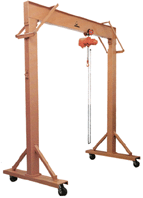Industrial Cranes Information
 Industrial cranes raise, shift, and lower loads with a projected, swinging arm or a hoisting apparatus supported on an overhead track.
Industrial cranes raise, shift, and lower loads with a projected, swinging arm or a hoisting apparatus supported on an overhead track.
Types of Industrial Cranes
Bench or cart-mounted cranes are designed for small workspaces and one-hand operation.
Jib cranes mount on walls or floors and consist of a horizontal beam (jib) upon which a shuttle or hoist is mounted. Floor or foundation-mounted jib cranes have higher load ratings than wall-mounted cranes. A cantilevered jib crane can incorporate full or partial rotation.
Gantry cranes have a horizontal beam and end supports or legs. Machines range in size from small, workstation cranes to very large, heavy-duty construction cranes.
Overhead cranes or bridge cranes attach a horizontal load-carrying beam to wall columns (overhung) or the underside of the ceiling (underhung).
Boom cranes use a structure, pole or boom to support a suspended cable for load attachment.
Tower cranes use a cantilever boom, but are designed for very heavy-duty operations.
Mobile cranes and truck-mounted cranes can be moved or driven to different locations.
Ship cranes and deck cranes are designed for shipboard mounting and the loading or ships, freighters, and other maritime vessels.
Stacker cranes are similar to bridge cranes; however, instead of a hoist, these industrial cranes use a mast with forks or a platform to handle unit loads.
Video Credit: Air Technical Industries
Specifications
Industrial cranes differ in terms of product specifications, features, and applications. Performance specifications to consider include:
- Load capacity
- Vertical available
- Lifting height
- Horizontal available span
Features
Products such as tower, davit and jib cranes have a titling boom. Machines with a cantilevered boom or a jib that can be rotated with our without a load are also available. Industrial cranes with wheels are designed for load transport and positioning. Typically, these machines are equipped with a brake or stabilizing outriggers. Industrial cranes that provide motorized motion move loads with a motor instead of manual pulling. With some applications, an industrial pendant is used to enable an operator to actuate lift or trolley travel. There are many different sizes of industrial cranes. Small site-based cranes are used for designed for on-site applications. Immense tower cranes and deck cranes are designed to move cargo containers, steel and concrete; large tools such as acetylene torches and electrical generators; as well as a wide variety of other building materials. For custom or special-use cranes, check with the manufacturer for details.
Video Credit: Demag Cranes
Standards
- A-A-59218 - Cranes, Hydraulic, Carrier Mounted
- AIST TR-06 - Specification for EOT Cranes for Steel Mill Service
- API RP 2D + REDLINE - Operation and Maintenance of Offshore Cranes
Image credit:
Air Technical Industries
- Alabama
- Arkansas
- Arizona
- California
- Colorado
- Connecticut
- Florida
- Georgia
- Iowa
- Idaho
- Illinois
- Indiana
- Kansas
- Kentucky
- Louisiana
- Massachusetts
- Maryland
- Maine
- Michigan
- Minnesota
- Missouri
- Mississippi
- Montana
- North Carolina
- Nebraska
- New Hampshire
- New Jersey
- New Mexico
- Nevada
- New York
- Ohio
- Oklahoma
- Oregon
- Pennsylvania
- Rhode Island
- South Carolina
- Tennessee
- Texas
- Utah
- Virginia
- Washington
- Wisconsin
- West Virginia
- Wyoming
- 2 ton gantry crane
- bridge crane design
- overhead crane specification
- 1 ton jib crane
- gantry crane specification
- crane manual
- jib crane foundation
- nautilus crane
- demag crane repair manual
- davit
- crane trolley
- jib crane design bearing
- lightweight crane
- manual overhead crane
- hydraulic truck cranes
- towable crane
- wet bench
- crane drawing
- crane pennant
- gib crane
- huisman crane
- kone crane
- mobile crane specification
- motivation jib crane
- portainer cranes
- skyhook aerial crane
- 5 ton crane
- abus crane
- budget crane
- crane AutoCAD
